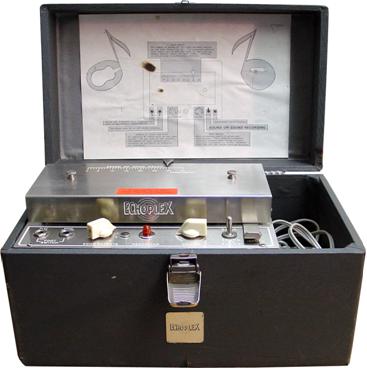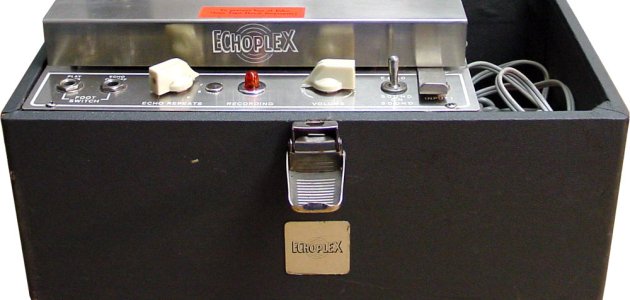Delay is one of the most commonly included effect types in a DAW package or multiFX processor. However, delay effects will often come in several different “flavours,” all with strange, cryptic names; Analog, Digital, Multi-Tap, Tape Loop, or Bucket Brigade. They’re all variants of the same device, they just produce the repeating effect using a different method, and as a result, there are different parameters and controls for altering the specifics of how it sounds.
Analog Delay Units
The first delay units were based on the experiments of early Electro-Acoustic composers. They consisted of an unbroken loop of ordinary magnetic tape, mounted on a player with multiple tape heads. The first head would record a sound, then the movement of the tape would send it toward the next one. As the second head played it back it would be partially erased, creating a quieter sound by the time it reached the next head. This created the classic repeating echo that fades with each loop.
Early models just involved mounting additional heads to a standard tape loop, but later commercial devices such as the Echoplex or Roland Space Echo added a variety of features, allowing users to alter the speed of the tape, or reposition the heads to change the pattern of the repeating sounds. These are considered the “Classic” analog delay units. They are highly sought after by Dub musicians and trip-hop audiophiles such as Portishead, The Beastie Boys, The Dust Brothers and Tricky. They have a charismatic, earthy sound, but lack the fine control available on digital units.

Image from HE Studiotechnik
Digital Delay
As the name suggests, digital delay units capture sounds played into the input in a digital memory bank, then plays it back according to the control settings. The use of digital recording allows for a wider array of controls. Digital delays are generally capable of much more extreme delay times. Modern units can record and play back minutes of sound rather than seconds, allowing a single instrumentalist to build up layers of harmonies and textures, creating complex multi-tracked pieces on the fly. This became the basis for the popular “looper” devices that appeared in the late 1990s. Alternately, digital delay units can have their repeat times shortened to milliseconds, creating glitchy, digital buzzing sounds that add warped fizzing textures to avant garde or minimalist pieces, such as those by Aphex Twin or Autechre.

The TC 2290 – One of the most popular Digital Delays
Because digital delay units can treat the input and output signals as totally separate sounds, they usually have a “Wet/Dry” or “Mix” control that allows you to balance the original and processed signals. Setting it to around 10% will create only a faint suggestion of the delayed signal, setting it to 100% will output only the processed sound, muting the original input. The “Feedback” control will control the length of time that the repeating signal runs for. On analog units this was hit and miss, but digital controls allow you to enter a precise number of milliseconds, or have the signal repeat infinitely.
Plug-Ins
As with most classic and highly expensive analog effects, there are simulated equivalents included as Plug-ins with many DAWs. Most will include a digital delay unit, and a simulated analog one, with controls that mirror their real-world counterparts. Being hard-wired into a DAW system has some advantages that can help you create some interesting effects. The tempo sync function used in synthesizer oscillators can also be used to match the speed of delay repetitions to the BPM of your track. If your plugin has a “Sync” button, engage it to snap the delay echoes to the beat of the song. The display on the “Rate” control will switch from milliseconds to fractions of a beat; 1/8, 1/16 and so on.

Reason’s DDL-1 has a “Unit” switch, rather than a “Sync” one.
Using a few of these units together with different step settings can allow you to create syncopated rhythmic patterns, transforming a simple drum loop into a clattering ensemble. Create three or four identical delay units and set them up as sends on the mixer. Set one to 4 steps of delay, one to 8, another to 16 and so on. Then play a simple drum loop through them and gradually turn up the return controls on the mixer. The silent spaces in the dour “kick and snare” drum loop will be filled with complex and intricate fills that evolve and change with each repetition.
Each of the different types of delay unit perform the same task, they record a sound, then play it back repeatedly, each repetition fades in volume until it disappears completely. Regardless of the type of unit, there will always be controls for the rate of repetition, and the speed at which the echo fades. The other controls will vary depending on the model, but provided you set these first two correctly, so the echoes fit the rhythm of your song, and die out at the appropriate time, anything else is just fine tuning.




